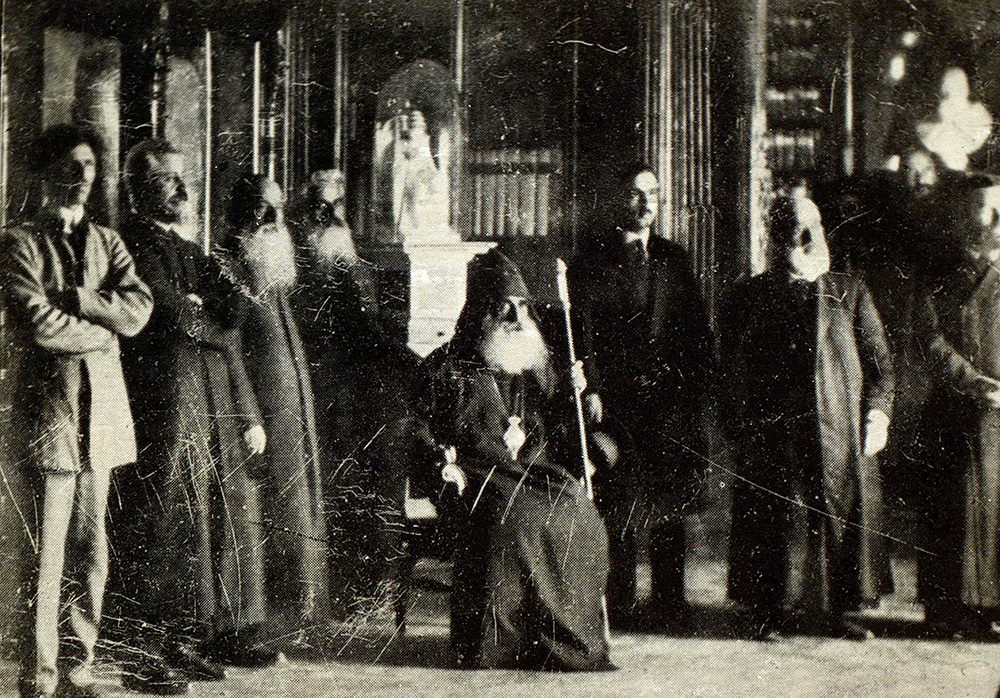
His Holiness Sahak II Khapayan, Catholicos of the Great House of Cilicia, closely followed the fate of the Armenian deportees exiled to the Mesopotamian deserts during the years of the Armenian Genocide. The Catholicos moved from the Catholicossate in Sis to Aleppo in 1915, created the Deportees’ Committee and appealed to Constantinople and abroad for help. He had meetings with the Governor of the province of Aleppo, Jelal Bey, obtaining permission for several priests to carry out their duties. The latter went to Bap, Manbij, Deir Zor, Idlib and Maara with the aim of assisting the deportees. The Young Turks’ government officials, in parallel with the flow of deportees arriving in Aleppo that increased day by day from the deserts, hampered the activities of the Deportees’ Committee, even arresting the deputy spiritual leader of the Aleppo Armenian national prelacy Fr. Harutyun Yesayan and several other clergymen. The Deportees’ Aid Committee, however, reformed, with newmembers and headed by Fr. Khachatour Poghikyan, continued its work, overseeing three orphanages in Aleppo caring for 800 orphans.
His Holiness Catholicos Sahak was, in October 1915, exiled to Idlib in accordance with the order issued by the Turkish Minister of the Interior Mehmet Talat. However, receiving the title of “Catholicos of All Armenians in Turkey” on 9 August 1916, he moved to Jerusalem and continued organizing the work of sheltering and caring for the deportees. After the liberation of Syria, Lebanon and Jerusalem in 1918, Catholicos Sahak had meetings with Emir Faisal of Syria, securing guarantees for the settlement of the deportees as well as assistance for the freeing of Armenian children from Muslim families. At the same time, the Catholicos’ supporters, Bishops Petros Sarajyan and Yeghishe Chilingiryan, organized the issue of shelter for the deportees in Damascus and Aleppo.
In September 1919 Catholicos Sahak, with the Armenians of Cilicia, returned to Adana. He repeatedly requested statistics from all the religious leaders of deportee-inhabited areas concerning their state, with the object of organizing the provision of necessary aid for them. The Catholicos personally supervised the work of the Armenian national orphanages in Cilicia. He concerned himself with the state of the orphanages funded by foreign organizations and the future fate of the orphans themselves. He also corresponded with the French High Commissioners of Syria and Cilicia. Catholicos Sahak, accompanied with his translator V. Khoubeseryan and advisor Z. Pztikyan, went to Europe from March to 1 November 1920 to defend the issue of Cilicia. He then, after the signing of the London Agreement of May 1921 and Franco-Turkish Agreement in Ankara on 20 October, when the French Army withdrew from Cilicia, had to organize the Armenian people’s systematic evacuation from Cilicia. Catholicos Sahak only left for Aleppo after organizing the departure of around 20.000 Armenians from the port of Mersin to Cyprus, Syria, Lebanon, Palestine, Greece and Smyrna. During his years as Catholicos he periodically visited Beirut, Alexandretta, Damascus and Tripoli, had meetings with local authorities and clergymen and visited the deportees. Catholicos Sahak finally went to the catholicossal residence in 1930, when the Catholicossate of Cilicia was finally established in Antelias, Lebanon. The role of the Catholicossate of the Great House of Cilicia and Catholicos Sahak in person was of great importance in the preservation and revival of the Armenian nation.

Sahak II Khapayan (1849-1939), Catholicos of the Great House of Cilicia
AGMI Collection

The local committee of Mersin at the AGBU orphanage with Sahak II Catholicos
A Century of History of the Armenian General Benevolent Union, 1906-1940, vol. 1, Cairo-Paris-New York, 2006 (in Armenian)

Visit of Sahak Catholicos to the Dort-Yol Kelekian Orphanage
A Century of History of the Armenian General Benevolent Union, 1906-1940, Vol. 1, Cairo-Paris-New York, 2006 (in Armenian)

The Students of the AGBU Orphanage of Mersin during the Visit of Sahak II Catholicos, 1920
A Century of History of the Armenian General Benevolent Union, 1906-1940, Vol. 1, Cairo-Paris-New York, 2006 (in Armenian)

The Visit by Sahak II Catholicos to the Dort-Yol Orphanage
Les Arméniens, 1917-1939. La quête d’un refuge, Beirut, 2006

Residents of the AGBU Aleppo shelter with the members of the orphan-gathering committee. from the left Tigran Jikaryan, Gabriel Khanjyan, Fr. Harutyun Yesayan (between two french officers), Gabriel Gasparyan, Onnik
Mazlumyan, Manuk Sahakyan, Dr. Khachaturyan
Mihran Minasian’s Collection

Visit of Catholicos Sahak to Mekhitarist Congregation in St. Lazarus Island of Venice, 5 May, 1920
National Archives of Armenia

Visit of Catholicos Sahak to Mekhitarist Congregation in St. Lazarus Island of Venice, 6 May, 1920
National Archives of Armenia





